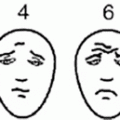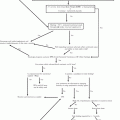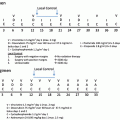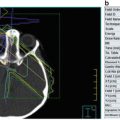Symptom/exam finding
Laboratory finding and/or cause
Hematological
Pallor
Anemia due to decreased red blood cells
Fatigue
Anemia due to decreased red blood cells
Bruising
Thrombocytopenia due to decreased platelets
Bleeding (nose, GI tract, CNS)
Thrombocytopenia due to decreased platelets
Petechiae (tiny red spots that don’t blanch with pressure)
Pinpoint hemorrhages in the skin due to decreased platelets
Fever
Infectious or noninfectious; often resolves quickly with onset of ALL therapy
Infection
Decreased neutrophils and/or impaired neutrophil function
Non-hematological
Bone pain
Expansion of marrow space due to replacement by leukemia; may manifest as irritability and refusal to walk in young children
Joint pain or swelling
Infiltration with leukemia cells; may lead to misdiagnosis as juvenile rheumatoid arthritis and/or rheumatic fever
Hepatomegaly and/or splenomegaly
Infiltration with leukemia cells
Lymphadenopathy
Infiltration with leukemia cells
Testicular enlargement
Infiltration with leukemia cells; typically rock-hard, painless, lumpy
Somnolence
CNS involvement and increased ICP
Headache and/or neck pain
CNS involvement and increased ICP
Vomiting
CNS involvement and increased ICP
Cranial nerve palsies
CNS involvement
Seizures
CNS involvement
Respiratory and/or cardiac compromise
Mediastinal mass obstructing airway and/or pleural or pericardial effusions; most common with T-cell ALL
Elevated LDH
Rapidly proliferative leukemia; seen especially with high WBC count, infant ALL, T-cell ALL, or Burkitt’s leukemia
Renal dysfunction
Kidney injury due to tumor lysis and/or infiltration of kidney with leukemia cells; seen especially with high WBC count, infant ALL, T-cell ALL, or Burkitt’s leukemia
Rash (raised blue lesions)
Skin infiltrations; seen particularly in young infants where may be confused with congenital cytomegalovirus infection
Table 16.2
Differential diagnosis of ALL
Disease(s) | Important distinctions |
|---|---|
Hematologic and oncologic disorders | |
Acute myeloid leukemia (AML) | Symptoms similar; morphology of blasts in PB and/or BM is different; cytochemical staining of PB/BM samples may be required to differentiate ALL and AML blasts |
Non-Hodgkin’s lymphoma (NHL) | T-NHL and T-ALL may have very similar symptoms and findings; usually treated in same manner |
Metastatic solid tumors | May see marrow replacement with small round blue cell tumors such as neuroblastoma, rhabdomyosarcoma, or Ewing sarcoma; primary solid tumor usually, but not always, present on physical exam or X-rays studies; special stains of BMA/Bx may be required |
Idiopathic thrombocytopenic purpura (ITP) | Isolated thrombocytopenia in ITP; typically otherwise healthy with sudden onset of bruising/bleeding; BM morphology shows abundant megakaryocytes and normal other cells in ITP |
Severe aplastic anemia (SAA) | Pancytopenia may be seen in both ALL and SAA; BMA/Bx is severely hypocellular/empty in SAA but packed in ALL. ALL sometimes presents with pancytopenic phase and serial BMA/Bx may be needed to establish diagnosis |
Myelodysplastic (MDS) and/or myeloproliferative (MPD) disorders | Pancytopenia may be seen in both ALL and MDS/MPD; BMA/Bx +/− special stains needed to establish distinction |
Hemophagocytic lymphohistiocytosis (HLH) | HLH can present with fever, systemic illness, pancytopenia, hepatosplenomegaly, and lymphadenopathy. BMA/Bx may be required to establish correct diagnosis |
Non-hematological disorders | |
Juvenile rheumatoid arthritis (JRA) | Small percentage of ALL cases present with prominent joint symptoms and fever and can be confused with JRA; BMA/Bx should establish correct diagnosis |
B12 or folate deficiency | B12 and folate deficiency primarily cause anemia with characteristic red blood cell morphology; B12 deficiency may be associated with neurological symptoms |
Infections | |
Viral infections EBV, CMV, etc.) | Can present with fever, hepatosplenomegaly, generalized lymphadenopathy, and elevated white blood cell count with marked lymphocytosis; lymphocyte morphology can help distinguish from ALL but BMA/Bx may be needed to establish diagnosis |
Dengue fever | Dengue associated with fever, headache, muscle and joint pains, and frequently with measles-like rash. Some cases have low white blood cell and platelet counts with bleeding; Dengue endemic in many areas of tropics and subtropics; may need BMA/Bx to establish correct diagnosis |
Simple laboratory tests readily available at most hospitals are needed to establish a diagnosis of ALL including a complete blood cell count with microscopic examination of a peripheral blood smear. In most cases a bone marrow (BM) aspirate/biopsy with microscopic examination is performed to establish the diagnosis. The peripheral blood or BM smear, or biopsy touch preparation is generally stained with Wright’s stain (or a variant such as the Wright-Giemsa stain) to identify the different types of blood cells. In some cases additional cytochemical stains are used to distinguish ALL from acute myeloid leukemia (AML), including Sudan black, myeloperoxidase, and nonspecific esterase. In HIC flow cytometry is almost always used to definitively establish the diagnosis of leukemia, the subtype (ALL vs. AML), and immunophenotype (B-cell precursor vs. T-cell ALL). While this information is very useful, particularly when therapy may be tailored to immunophenotype in HIC, it is not required for the diagnosis and effective treatment of ALL. The flow cytometry machines and reagents are typically very expensive and not usually available in resource-limited settings present in many LMIC. However, if present, simplified algorithms have been established that can facilitate diagnosis and monitoring of ALL treatment response (minimal residual disease) at relatively low cost [18].
There are several systems that have been used to classify ALL based on morphology and/or immunophenotype. For many years the French–American–British (FAB) system that classified cases as L1, L2, or L3 based on morphology was used [19]. This classification is useful mainly for the recognition of the distinctive L3 morphology of Burkitt’s leukemia. This subtype comprises only 1–2 % of childhood ALL cases in HIC, but requires very different treatment, similar or identical to that used for advanced stage Burkitt’s lymphoma, than other ALL cases [20]. Other than this, the FAB classification of ALL does not provide significant clinical utility and has been supplanted by the 2008 World Health Organization (WHO) classification [21]. However, neither WHO nor FAB classification is needed to treat ALL in LMIC.
Important Issues in the Initial Medical Management of Children with ALL
The specific approaches to ALL treatment are discussed below. Induction chemotherapy typically lasts 4 weeks and consists of three or four drugs administered orally, intramuscularly, or intravenously including a corticosteroid (prednisone [PRED] or dexamethasone [DEX]), vincristine (VCR), and an asparaginase (ASNase) preparation with or without an anthracycline. A simple 2-drug 4-week PRED/VCR regimen with or without intrathecal chemotherapy will induce complete remission in about 85 % of children with ALL, and this rate can be increased to 95 % or higher with the addition of ASNase [22]. Even this simple regimen produced TRM rates of 3–5 % when first introduced in HIC in the 1970s. Thus, vigorous supportive care is essential.
Metabolic derangements and supportive care: Children with ALL can present with high white blood cell (WBC) counts and lymphoblasts can undergo lysis either spontaneously or after treatment is begun. Dying WBC release intracellular contents including potassium, phosphorus, and DNA that is metabolized via the uric acid pathway [23]. Acute tumor lysis syndrome (TLS) is characterized by hyperkalemia, hyperuricemia, hyperphosphatemia, and secondary hypocalcemia. It is classified as laboratory TLS if only metabolic abnormalities are present and clinical TLS when this is accompanied by clinical symptoms including renal dysfunction manifested as increased creatinine, cardiac rhythm disturbances (due to hyperkalemia), seizures, or death. The risk of TLS is highest in children with high and/or rapidly increasing WBC and/or bulky extramedullary disease; thus, major risk factors for TLS include WBC >100,000/μL, infant ALL, T-cell ALL, and Burkitt’s leukemia. The risk can be exacerbated by dehydration and/or malnutrition, and delayed diagnosis, all of which are common in LMIC.
Symptoms of TLS are caused by the metabolic derangements listed above. The problems are often exacerbated by formation of calcium phosphate and/or uric acid crystals in the kidney that cause acute renal injury leading to further impairment in urine output and increased metabolic abnormalities. Measures used to prevent TLS include vigorous intravenous hydration where possible, usually at twice maintenance fluid requirement rates or 3,000 mL/m2/day. Urine output should be at least 2 cc/kg/h and preferably 3–5 cc/kg/h. Loop diuretics such as furosemide may be needed to insure adequate urine output and to make sure that fluid input and urine output are matched. Because higher urine pH increases the solubility of uric acid, bicarbonate (40–80 mEq/L) is usually added to intravenous fluids to prevent uric acid precipitation in renal tubules. However, higher urine pH promotes calcium phosphate crystallization, so caution must be used. Allopurinol, which inhibits the enzyme xanthine oxidase needed for uric acid formation, is administered 50–100 mg orally three times/day to prevent TLS. Ideally hydration, urinary alkalinization, and allopurinol should be given for 12–48 h prior to the start of chemotherapy and continued for the first 3–7 days of treatment. This may not be possible in patients that present with very high WBC and signs/symptoms due to leukostasis.
In the worst cases, TLS can be fatal due to renal failure and/or cardiac dysrhythmias. However, clinically significant TLS can be prevented or managed successfully in the overwhelming majority of children with ALL using the measures discussed above, even with oral hydration when necessary due to local conditions.
Transfusion support: Children with ALL frequently present with or develop symptomatic anemia and/or thrombocytopenia. Prior to the advent of effective ALL therapy, death due to anemia and/or bleeding was common, and this remains a major concern in LMIC. In HIC that almost always have well-established blood banks and ready access to red blood cells and platelets for transfusion, this problem is relatively simple to manage and transfusions are typically provided to treat symptoms of anemia or thrombocytopenia, or prophylactically when blood values fall below certain levels (typically 7–8 g/dL of hemoglobin or hematocrit <20 %, and platelet count <10–20,000/μL). In contrast, access to and the safety of blood components for transfusion are major problems in LMIC. Even when transfusions are feasible, they are often very expensive and available only if the family is able to pay. In the absence of a volunteer blood banking system as present in most HIC, family members and friends may need to be recruited to provide blood for transfusion to children with ALL and testing for blood-borne infectious agents such as Hepatitis B and C and HIV may not be readily available. Development of an effective blood banking system is often a major barrier that must be overcome as ALL treatment programs are established at LMIC centers. When possible, blood products should be irradiated to decrease the risk of transfusion-acquired graft versus host disease.
Treatment and prevention of infections: Another major cause of morbidity and mortality in children with ALL is infections. Bacterial and fungal infections are particularly problematic during induction therapy or during intensive phases of post-induction therapy. Because prolonged corticosteroid use is associated with oral and vaginal yeast infections, especially candida albicans or other candida species, most children with ALL receive oral nystatin (or similar agents) during induction or other periods of prolonged corticosteroid use. Fluconazole and itraconazole may be more effective than nystatin, but are much more expensive, can be associated with hepatotoxicty, and alter the pharmacokinetics of vincristine.
Bacterial infections occur commonly in children with ALL, particularly in association with neutropenia. Intravenous antibiotics should be given when fever develops and the absolute neutrophil count (ANC) is <500/μL or if there is concern about systemic infection based on other clinical considerations. The choice of antibiotics will vary based upon the local experience regarding the type of organisms that are prevalent in the population and the pattern of local antibiotic resistance. In general, treatment should include coverage for enteric gram negative organisms such as E. coli and Pseudomonas aeruginosa and gram positive organisms such as Staphylococcus aureus.
A unique problem for children with ALL is the risk of Pneumocystis carinii (now termed Pneumocystis jiroveci) pneumonia (PCP). Prior to the advent of effective prophylaxis, 20–25 % of children treated for ALL developed PCP, often with fatal consequences [24]. Prophylaxis with trimethoprim-sulfamethoxazole (TMP/SMX) is highly effective [24, 25], and children with ALL should receive PCP prophylaxis with TMP/SMX at a dose of TMP 5 mg/kg/day in two divided doses given on 2–3 consecutive days each week starting soon after diagnosis and continuing until 3 months after ALL therapy is completed. Those unable to tolerate TMP/SMX can be treated with Dapsone (1–2 mg/kg/day; maximum dose 100 mg/day) or atovaquone (30–45 mg/kg/day). Aerosolized pentamidine given every 4 weeks is also an option, but this is less likely to be available in LMIC.
Venous access: Because ALL treatment involves multiple doses of intravenous chemotherapy with drugs that are vesicants (vincristine, anthracyclines) and can cause significant injury to the skin and tissue if they extravasate, almost all children with ALL in HIC have an indwelling central venous catheter. These are almost never available in LIC and variably available in MIC. Hence, most children will receive ALL chemotherapy through peripheral intravenous catheters (IVs) inserted specifically to administer the chemotherapy. Significant care must be taken to insure proper IV placement before administration of vesicant agents.
Varicella: Another significant concern in children with ALL is development of a primary varicella infection or reactivation of the varicella-zoster virus (VZV) causing shingles. In the United States, primary varicella infection in children with ALL is now rare due to near universal vaccination against VZV. However, VZV vaccination is uncommon in LMIC and primary varicella infection occurs frequently and can cause significant morbidity including visceral and CNS involvement, secondary bacterial infection, and post-VZV inflammatory complications [26]. Without effective antiviral therapy and supportive care, primary VZV infection during ALL treatment is associated with a 5–10 % risk of mortality [27]. With effective therapy, death is uncommon; a recent review of primary varicella infection in HIC showed only 20 deaths among over 35,000 children with ALL, with 14 of these 20 deaths occurring in the first year of therapy [27]. Following a documented exposure to VZV in a nonimmune patient varicella-zoster immune globulin (VZIG) can be given if available. It is essential to isolate exposed patients from other patients for 21 days following exposure (28 days if VZIG is administered) to prevent nosocomial outbreaks. If clinical varicella develops, treatment with intravenous acyclovir 500 mg/m2/dose three times daily (or related antivirals) should be given immediately and therapy should be continued until all lesions are scabbed and no new lesions have developed for 24 h. Renal dysfunction can develop with IV acyclovir treatment, so patients should receive IV fluids and creatinine levels should be monitored closely. It is reasonable to transition to oral therapy after 3 days of IV therapy if the patient is responding well. Chemotherapy, particularly corticosteroids, is generally suspended during treatment of active infection, but this may not be possible if a patient develops varicella in the first few months of therapy. Good data do not exist regarding acyclovir treatment at the time of exposure, but this practice is common in many LMIC. For example, in Guatemala, if a patient has been exposed and has had no varicella in the past, acyclovir is given orally at 30 mg/kg/day for 7 days, starting 10 days after the exposure. Results are good with this approach (Melgar M, Antillon F, personal communication). Development of shingles during ALL therapy can also be associated with significant complications and treatment with an appropriate antiviral is indicated (IV acyclovir is usually given at half the dose used for treatment of primary VZV). Because immunocompromised patients can have viremia and shed virus via aerosol routes, ALL patients with shingles should be isolated until the infection is resolved.
Nutritional assessment and support: The incidence of malnutrition in LMIC children can be as high as 50 % and the presence of malnutrition can have a major impact on the tolerance, effectiveness, and safety of ALL treatment [28]. Simple anthropomorphic measurements, including triceps skin fold thickness (TSFT) and mid upper arm circumference (MUAC), can be used to assess nutritional status. Antillon and colleagues recently reported that more than 50 % of children diagnosed with ALL in Guatemala had moderate or severe nutritional deprivation at the time of initial diagnosis, that severe nutritional deprivation was associated with an increased risk of treatment abandonment and relapse, but that the risk of death was decreased significantly in children that improved their nutritional status in the first 6 months of therapy [28]. Algorithms have been developed to guide nutritional interventions in AHOPCA that should be widely applicable to other LMIC [29]. A major focus of support efforts for the families of children with ALL in LMIC is often the provision of food baskets that can provide nutritional support to the patient, siblings, and other family members, thereby decreasing financial pressures that may lead to abandonment.
Antiemetic therapy: Nausea and vomiting secondary to chemotherapy can be prevented in most cases. Every effort should be made to prevent this side effect and to provide adequate antiemetic drugs. Preventive treatment should start before chemotherapy is given and should continue as long as nausea and vomiting are likely to be produced. Scheduled antiemetic doses should be given regardless of symptoms. Nevertheless, drug costs for 5-HT3 receptor agonists may be a limiting factor in LMIC. If cost is an issue the use of metoclopramide, diphenhydramine, and dexamethasone is useful if chemotherapy has a mild or moderately emetogenic potential. If the emetogenic potential is high, 5-HT3 receptor agonists should be used if possible.
Abandonment of therapy: Abandonment of therapy is a major cause of treatment failure in most LMIC affecting 40–60 % cases [30, 31]. The AHOPCA group defines abandonment as an interruption of 4 or more weeks of scheduled therapy; this has been suggested as a uniform definition by the SIOP Abandonment Working Group [32]. Successful interventions have been used to prevent abandonment in different countries. At the National Pediatric Cancer Unit in Guatemala, abandonment has decreased from the historic 42 % before opening of the cancer center to less than 2 % in 2011 for all types of pediatric cancer through the establishment of a psychosocial team including both social workers and psychologists whose aim is to support families throughout the cancer experience, and provide funds for transportation, lodging, and food baskets when necessary (Silvia Rivas F and Antillon F, unpublished observations). In Recife, Brazil, through the provision of lodging, social work, transportation, and food subsidies, and the establishment of a parent group, a fundraising foundation, and a patient tracking system, abandonment among children with ALL decreased from 16 % in 1980 to 1 % in 2002 [12].
General Concepts of Pediatric ALL Treatment
Treatment for ALL in HIC consists of complex combination chemotherapy regimens that last about 2.5–3 years, with 6–8 months of relatively intensive therapy followed by 1.5–2 years of low intensity maintenance therapy during which most children can resume normal activities and attend school. A core set of chemotherapy drugs needed for treatment of childhood ALL has been defined (Table 16.3) with additional information available regarding drugs needed for pediatric oncology treatment in LMIC [33, 34]. These drugs have been widely available in HIC for many years; most are readily available in LMIC and relatively inexpensive, with the exception of asparaginase preparations, which can be extremely expensive in both LMIC and HIC.
Table 16.3
Drugs used to treat pediatric acute lymphoblastic leukemia
Class | Specific drugs | Phase of therapy | Route of administration |
|---|---|---|---|
Corticosteroids | Prednisone, dexamethasone | Induction, reinduction, maintenance | PO, IV |
Vinca alkaloids | Vincristine | Throughout therapy | IV |
Asparaginase preparations | E. coli asparaginase, PEG-asparaginase, erwinia asparaginase | Induction, reinduction | IM, IV |
Anthracyclines | Doxorubicin, daunorubicin
Stay updated, free articles. Join our Telegram channel
Full access? Get Clinical Tree
 Get Clinical Tree app for offline access
Get Clinical Tree app for offline access

|




